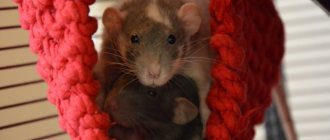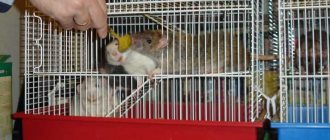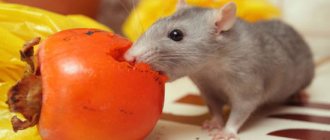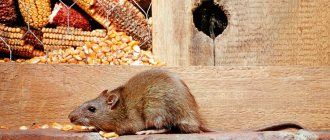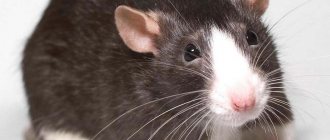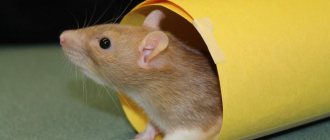Rats can eat any food and are prone to overeating. Therefore, they can quickly gain unhealthy weight. This can lead to serious illness.
If you want your rodent to remain healthy, you need to monitor its weight. It is important to know the standard parameters of rats to determine whether the animal is developing properly and what its health status is.
What determines the size and weight of rats?
The body weight and size of a rodent depends on several factors:
- The species to which the animal belongs. For example, small rats (Rattus exulans) weigh about 70 g and are only 14 cm long. But pasyuks, which are familiar to humans, grow to 20-25 cm and gain a weight of 200-390 g.
- Gender of the rodent. Males, both in nature and among ornamental representatives of this species, are approximately 10-15% larger than females.
- Hereditary data. If the cub's parents are small, then it is unlikely that it will grow into a large rat. This also works in the opposite direction. In large individuals, the appearance of small offspring indicates some kind of pathology or unfavorable factors during the female’s pregnancy.
- Food and living conditions. The ability to obtain adequate nutrition directly affects how much a rat will weigh. If during pregnancy the female does not receive adequate food, the offspring will be more frail. Vitamin and mineral deficiencies during infancy also affect adult size. The animal will be weak and noticeably smaller than its fellows.
- A calm, comfortable environment has a beneficial effect on the weight of animals. A state of constant stress can inhibit development in small rodents.
- Health. The size of an adult rat is directly related to the condition of its body. Of course, it will not become larger than the parameters assigned to it by nature, but excessive thinness and weight loss are direct evidence of an illness in the animal.
Homemade
Measuring the mass of a rodent is simple; just place it on some sensitive scale. Kitchen ones are also suitable. But there are problems with measuring length. The plastic structure allows them to both stretch the body and compress it. The difference in numbers will be colossal.
Giant rats: myth or reality
Surely each of us has heard creepy stories about giant rats living in abandoned buildings and subways. There are a huge number of articles in newspapers and magazines, and people, reading such stories, believe in it and are really afraid that one day they will meet a mutant rat in person and will definitely take it to their home.
In fact, these are all unconfirmed myths, and the press uses them to attract readers and increase demand for their magazines and newspapers.
The largest rat in Russia is the pasyuk, its size does not exceed the size of an ordinary cat. Of course, their dimensions can be quite impressive, but this is not the result of a mutation, but simply an abundant diet. Pasyuk is definitely not a bloodthirsty monster and does not attack people. Therefore, you shouldn’t believe in mutant rodents, much less be afraid of them.
The largest and smallest rats in the wild
Species of rats differ among themselves in their habitat (some prefer to live close to humans, others far away), in size, and taste preferences. People have known some of the representatives of rodents since ancient times, and some they met quite recently.
- The giant Papuan or Bosavi woolly rat does not even have a scientific name yet. It was discovered in 2009 on the island of Papua, which belongs to the territory of New Guinea. It received its temporary name due to the crater of the Bosavi volcano, where it was discovered. Perhaps it can be considered one of the longest rats, since the size of the body reaches 1 meter, plus a tail of about 30 cm.
- Cane rats or bristle pigs are real giants. Despite the body length of 55-60 cm, the weight of females reaches 4-5 kg, and in males it can reach up to 9 kg. They live in equatorial and southern Africa.
- In Russia, the largest breed is the pasyuk or gray rat . Its body length is 17-25 cm, and its weight is 140-390 g.
- The size of the smallest rat found in the wild barely reaches 11–15 cm, weight from 40 to 80 g. The little ones live in New Guinea, the Pacific Islands, and Southeast Asia. In addition to the official name - small , they are also called Pacific or Polynesian .
Children's legends about mutant rodents that appeared due to environmental problems do not have any supporting facts.
Population and species status
Since the beginning of the third millennium, black rat populations have declined markedly and become fragmented. According to experts, black rats have begun to be replaced by more fertile gray rats (pasyuki). And yet, despite the high fertility, rat populations do not go beyond the “Red Line”, since their numbers are controlled by a number of important factors.
Firstly, the number of these animals directly depends on the availability of food and shelter. Lack of food immediately leads to a decline in population. In addition, there are special rat control services. The number of these animals is constantly declining as a result of certain diseases, as well as hunting by many predators. Therefore, despite their high fertility, which leads to constant surges in their numbers, natural factors, as well as rat control services, are doing their job.
Today, most species of rats are not even close to the risk zone, although there are very rare species that are protected. As a rule, the number of rare species largely depends on the life activity of people, who are developing more and more new territories that are related to the natural habitat of these species.
Franklin Island is home to a very rare species of “House Rats.” Due to the fact that the species lives in a limited area, it is classified as an endangered species. Currently, only about 2 thousand individuals live in this territory. Annual deforestation and fires can reduce kangaroo rat populations.
The largest city rats
City rats are the same animals that live in rural areas. For a long time, black representatives of this family settled in the attics and basements of houses, lurked around the streets and spoiled the supplies of the townspeople, and served as a source of various diseases. In the 18th century, gray rats began to spread from port cities throughout Europe. Larger, aggressive, eating not only grain reserves, but also meat products, they became a disaster.
A big street rat could drag away a chicken, attack a small child, and, driven into a dead end, bravely fought with cats and dogs. Gradually displacing black rats, pasyuks began to spread throughout all the countries where people live. The most important thing for these animals is the availability of water and food. The only place they avoid is heights. It is almost impossible to meet them on the upper floors of skyscrapers. That's why there are still black rats there, which prefer dry attics. The native element for gray rodents is basements, communications, metro lines, sewers.
Wild animal
Any measures to destroy pasyuks only temporarily reduce their colonies. Smart animals with a clearly constructed hierarchy and defined roles within the group never risk the entire flock. They quickly learn to avoid any human traps and can temporarily leave dangerous territory. But as soon as the colony grows, everything will return to normal.
Interesting facts about the rodent:
- Rats cause economic damage as they eat and spoil food and non-food products, damage electrical networks, and cause damage to agriculture. In addition, they are a natural reservoir for many zoonotic and anthropozoonotic infections (plague, tularemia, rabies, typhus, toxoplasmosis, leptospirosis, rickettsiosis). Therefore, many methods have been developed for their destruction - deratization. But rats can adapt to and recognize poisons.
- In the United States, rats bite about 14,000 people every year.
- Since the 19th century, specially bred rats have been kept as pets. They are also bred as “live food” for home terrariums and zoos.
- Rats are the main experimental system in biological and medical experiments. Special laboratory rats were bred for this purpose. They are distinguished by their fast metabolism, unpretentiousness and peaceful nature.
- Rats are considered very intelligent animals; along with humans, they have abstract thinking. In addition, they respond to tickling and produce ultrasonic laughter-like sounds.
- In China, the rat is a symbol of prosperity and the first animal to open the cycle of the eastern horoscope. In Islam, the rat is the embodiment of sensuality, and Hinduism represents the rat as a former demon.
Size and weight of pet rats
Artificially bred decorative rats are increasingly winning the love of humans. Having been born less than 70 years ago, thanks to a strict selection of producers, we managed to obtain affectionate, peace-loving and intelligent animals. Breeders, taking advantage of the rapid emergence of the next generation in these rodents, are excitedly developing new breeds.
Despite the fact that pets are all approximately the same size, there are several species with the largest rats.
- Brown. On average, the animals weigh 500-600 g, but some specimens reach 900 g. Although this cannot be called the norm. It is possible that the rodents are obese. Representatives of this species live only two years.
- Standard. One of the most common breeds. Affectionate and non-aggressive rodents rarely bite despite their very large size for an ornamental rat. They weigh up to 500 g, body length is about 30 cm.
- Dumbo. Representatives of this species were bred in California. Their large protruding ears give their faces a funny expression. The value of a breed representative is determined by the length of the ears. They grow up to 20 cm and gain a weight of about 400 g.
How to determine the age of a young rat
Upon reaching the age of 5-6 months, a young rat may still grow, but only a little. Experienced rat breeders advise focusing on the size of its tail when determining the age of an animal. The fact is that its growth continues for about 12 months.
In an adult, sexually mature rat, whose growth has finally stopped, the length of the tail is approximately equal to the length of the body (sometimes a little longer). Thus, if the tail is shorter than the body, the rodent has not yet crossed the annual mark. If the size of the tail is comparable to the size of the pet’s body, he is definitely already one year old.
Some physiological features of development that appear at a certain age can tell about the age of rat pups. For convenience, when determining the age of young animals, you can use the following table:
| Rat age (days) | Changes in the body |
| 3-4 | The ears open up |
| 8-10 | The first teeth appear |
| 14 | Girls develop 2 parallel lines of nipples on their abdomen |
| 14-17 | Babies open their eyes |
| 16 | The body is completely covered with fur |
| 19-40 | Molars begin to grow |
| 21 | Transition from breastfeeding to solid foods |
| 25-28 | Show complete independence from the mother rat |
It is worth noting that buying either an old or too young animal (less than 5 weeks old) can have negative consequences for the new owner. The fact is that from a psychological point of view, even one-month-old adolescents are not yet ready to move to a new place of residence and completely separate from their mother. If the rat's adaptation is not successful, the pet may even die.
Starting from 5 weeks, young males and females must be placed in different cages! Since at this age rats reach sexual maturity and are ready to mate.
Average size of baby rats based on their age
Rats are born blind, without fur and with closed ears. Weight at birth is only 4-6 g. Thanks to the mother's nutritious milk, babies grow quickly, adding 2-3 grams every day.
Already on the 10th day of life, they hear well, are covered with fluff, and begin to actively explore the available space. Their body weight increases 6 times during this time.
After 20 days from the moment of birth, rats become similar to adults and grow to a size of about 15 cm.
On the 25th day, the babies are separated from their mother, otherwise the female will independently expel the offspring from the nest into an independent life.
Active growth of young animals continues up to 6 months, but a rat can reach its maximum size only by the age of one year.
Young animals
Approximate weight of the animal depending on age:
- Newborn – 4–6 years.
- 2 months – 160–220 g.
- 3 months – 210–310 g.
- 4 months – 250–430 g.
- 5 months – 300–540 g.
We must not forget that the given indicators are averages, according to which you do not need to adjust your pet. If the animal is active, feels great, and its fur is shiny, then there is no need to try to feed it more high-calorie food or, conversely, limit its food intake.
Should you be afraid of giant rats?
Despite their size, giant breeds of rats are harmless and harmless to people; most individuals feed on fruits, insects, and plant foods. Rodents do not have the goal of attacking humans; moreover, they easily make contact with people and get used to them.
The only time to be wary of rats is when they move in packs. Their flocks consist of more than 100 individuals, which can attack in self-defense. But fortunately, it wasn’t easy to come across a whole pack of rats.
We dealt with the rats. What do you know about spiders? We have selected for you interesting photos and videos about the largest spiders in the world.
More about huge mutant rats
Yet stories of giant mutant rats in the Moscow metro or abandoned military bunkers remain surprisingly enduring. Their phenomenon is easy to explain: people do not want to put up with the dullness of their everyday lives and are willing to believe in almost any unusual and inexplicable phenomena, even frightening ones. After all, these “horror stories” give hope that the world around is not as ordinary and dull as it seems most of the time, and there is certainly a place in it for some mysteries - including mutant rats.
It is also useful to read: Interesting facts about gray rats (pasyuki)
Simply put, people want to believe in the existence of monster rats, and science fiction writers, horror film directors, and rumor mongers simply exploit these fears to their advantage. As a result, more and more new versions of “facts” and “eyewitness accounts” constantly appear, and the old ones are repeatedly altered and turned into more and more new versions, sometimes completely different from the originals.
For example, the stories allegedly told by Moscow metro drivers are very well known. According to them, in the farthest sections of the tunnels, the headlights of trains occasionally reveal huge rats the size of dogs crossing the tracks. Most of these stories are full of chilling details: in that brief moment that a ray of light snatches a rat from the darkness of the tunnel, the animal manages to look at the driver with evil green (in other versions - red) eyes, and then suddenly news appears that these animals no poison works. It is unknown which of the drivers tried to poison these mutants (just as the names of those who actually saw these animals are not known), but most storytellers consider it their duty to mention such immunity.
Also popular is an allegedly real story that happened to a group of Moscow diggers (specialists involved in the study of caves and artificial underground tunnels). In a sewer under the zoo, this team was attacked by five large rats the size of a dog, and the guys were saved only by throwing their crowbars at the animals and in this way scared them away.
This story was continued. They say that an anonymous person later called the diggers club and said that there were a lot of large rats in secret bunkers for storing radioactive waste. It is well known that the more secrecy and conspiracy theories there are in a story, the more popularity it will have...
There are also stories circulating among people about giant rats climbing out of manholes near landfills and scattering dogs there. Moreover, these stories are unusually tenacious: the first reports of such rats appeared back in 1989, and after that their number has only increased.
It is interesting to note that the less believable each particular story is, the more easily it spreads among the people. It is the details that seem fantastic that make such tales “hot”: either huge rats create the most complex organizations with commanders, pioneers and suicide bombers, or they deliberately feed on poisons or winding wires - there are countless such details.
Someone is even trying to mix together rumors about mutant rats and news about the discovery of Bosavi woolly rats. The result is a mix unimaginable for a specialist that, they say, scientists have discovered a new species of giant rats - Indonesian - in the Moscow subway. Why Indonesian? Simply because the name is simpler than “Bosavi woolly rat” or “Papua New Guinea rat.”
We will not waste time refuting such speculation, but will only say that none of these rumors have factual confirmation.
How to distinguish an old rat from a young one
As cruel as it may sound, pet store owners view old rats exclusively as stale goods. Therefore, they give sellers the appropriate instructions - at all costs, sell an elderly animal under the guise of a young one. In order not to fall for the tricks of unreliable entrepreneurs, you need to know the main differences between an old rat and a young one:
- Teeth . The tooth enamel of young rats has a yellowish tint, but it darkens with age. And by the age of 2 it becomes dark orange. Moreover, the incisors are much longer than those of young rodents, and the back of the teeth is noticeably ground down. Also, as rats age, they develop dental diseases, which lead to bad breath.
- Fat layer . In aging animals, subcutaneous fat gradually thins out, especially on the back. This feature is manifested by a protruding spine with clearly visible vertebrae. In young healthy animals, the bones are not visible to the naked eye.
- Tail . Young individuals are distinguished by a smooth tail, pleasant to the touch. Old rats' tails are rough, scaly, and easily become dirty and flaky. Also, with age, the pink tails noticeably darken, and in females they sometimes become covered with stripes.
- Wool . The young animals boast beautiful shiny fur, pleasant to the touch and shimmering in the light. The fur of an older rat is coarser, duller, and often ruffled. An aging pet may also experience partial baldness.
- Eyes . Young rats have bright, beady eyes. After one and a half years, the iris brightens, and a characteristic white rim appears around the eye. Rodents may also experience cloudy eyes as they age.
- Porphyrin . The secretion of reddish-brown fluid becomes more active with age. While young animals only occasionally experience moderate discharge from the eyes and nostrils, older animals often walk around with their faces stained with porphyrin.
How long after birth can you pick up
Seeing small newborn lumps swarming around an adult female, you just want to pick them up or at least touch them. Under no circumstances should this be done. Firstly, their body is still very fragile and the slightest wrong movement or compression can lead to injury to the baby. Secondly, after you hold the baby in your hand, its coat will acquire a specific human smell. Mother rats often abandon such babies: they stop taking care of them, don’t feed them, and don’t keep them warm. The result is inevitable death. Despite all the caring behavior of females towards their offspring, they can kill a baby that emits an alien odor.
You will be interested to know what to do if decorative rats fight among themselves.
By three weeks, babies already look strong enough and can eat “adult” food. Even if the female does not want to accept a cub that smells like a human, it will be able to live and feed on its own. Experienced rat breeders recommend not delaying the taming of decorative rats. When the animal is a month old, it needs to be taken as often as possible, then the baby will be more obedient and affectionate.



